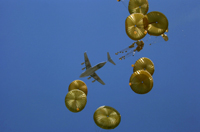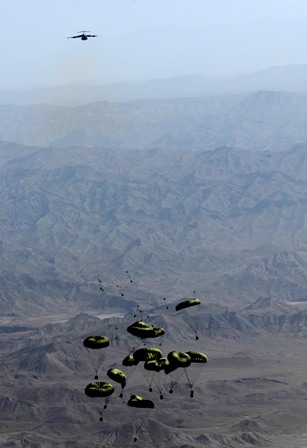Award-Winning Technology Improves Air-Drop Targeting - September 29,2008.
Wind-forecast software from NOAA that improves the target accuracy of an aircraft drop system up to 70 percent and is now being used in both Iraq and Afghanistan has won a federal technology transfer award for four scientists at NOAA's Earth System Research Laboratory in Boulder.

The software and drop system can be used for releasing almost any cargo from an airplane into a target area: water over a blazing wildfire, food to a famine-stricken population, or supplies, tanks, and Humvees into a war zone.
John McGinley, John Smart, Linda Wharton, and Daniel Birkenheuer won NOAA's Technology Transfer Award for successfully developing and transferring the wind analysis and prediction scheme to Planning Systems, Inc. (PSI), a military contractor based in Reston, Va., for use in its Precision AirDrop System (PADST). The awards were presented at a ceremony on October 22 at NOAA's Silver Spring, Md., campus.
"Reducing the landing zone size makes recovery less dangerous for ground-based military units, who often cross hazardous areas to reach supply drops," said McGinley. "More accurate targeting also allows the aircraft to fly at higher, safer altitudes."

The U.S. Air Force uses the system for dropping U.S. Army cargo and an occasional paratrooper into both Iraq and Afghanistan, according to McGinley. Inaccurate wind forecasts are the main culprit in missed targets for dropping supplies and other items from high altitudes, especially in mountainous terrain. The U.S. military faced this problem in aiming supply drops during the Bosnian war. Cargo intended for a small Bosnian valley sometimes landed in an adjacent Serb valley by mistake, according to McGinley.
In 1998 the Department of Defense started a program to develop a better system for air-dropping parachute payloads accurately and safely from high altitudes. PSI, a contractor working on the problem, asked NOAA for help.
McGinley's team focused on reducing the wind error. The result was new NOAA software that runs on a laptop computer onboard the aircraft. Called the Local Analysis and Prediction System, LAPS creates a weather snapshot using data from ground instruments, balloons, aircraft, satellites, and PSI-developed dropsondes - atmospheric observing devices dropped from aircraft. The improved wind forecasts in the final product reduced the average error distance between the center of the drop zone and the actual landing position from 5,000 to 1,300 feet, or 70 percent.
Better airdrop targeting can benefit civilian needs as well as military missions. A new firefighting method proposed by PSI and its partners would drop large containers of water over fires at night. If the method is implemented, accurate drops could mean the difference between dousing wildfire flames and soaking an area already charred.
PSI is now part of the QinetiQ North America Technology Solutions Group. The U.S. Army Natick Soldier Research Development and Engineering Center sponsored the LAPS software development and testing with U.S. Air Force and other Department of Defense sponsors. Draper Laboratory was the lead software integrator for PADS.
 Deep Sea Crabs
Deep Sea Crabs